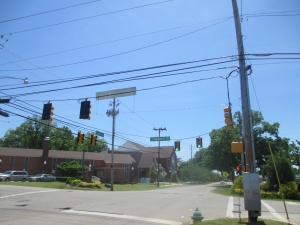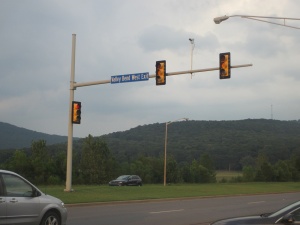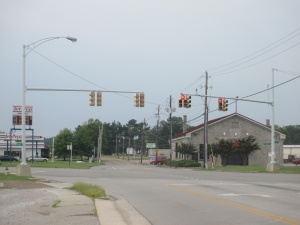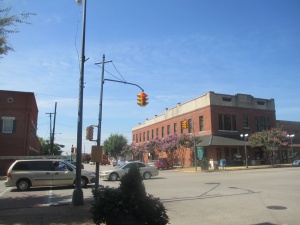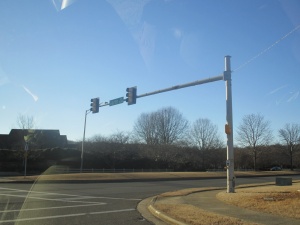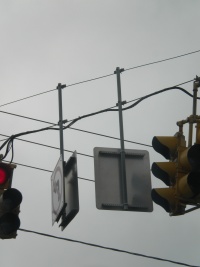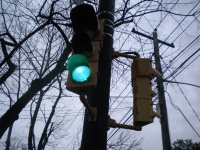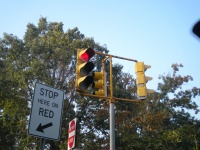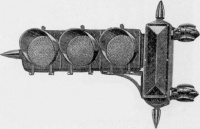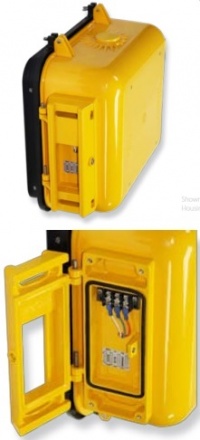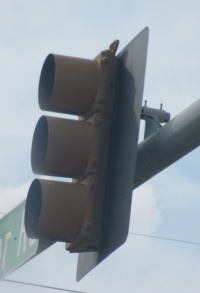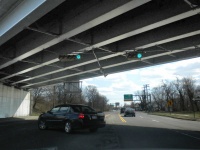Signal Mounting Styles
Out in the field, signals are always mounted to some solid object to keep them high up, to increase visibility and decrease likelihood of theft or vandalism.
Contents
Span Wires
One of the most common forms of holding signals and signs above intersections. Poles are erected at corners of an intersection, a cable is drawn between two poles, and signals are secured onto the cable with clamps, gooseneck hangers, and often cluster pipes and junctions. Wire is then run inside the pole from the cabinet, out the top at a weatherhead. The wires are secured to the cable and enter the signal clusters at the gooseneck hangers. Older span wire poles were either wooden or metal, all new installations are metal.
Diagonal Span
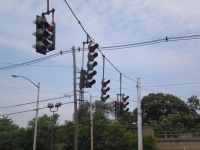
Utilizing a single cable and 2 poles, the cable is drawn between poles at opposite corners of the intersection. Signals are then free to face 4 or more directions in clusters or alone.
Box Span
Using 4 poles and 4 cables, poles are installed at each corner of a 4-way intersection, and cables are drawn to each pole, drawing a box shape if viewed from above. Signals are then mounted and generally positioned to face the traffic across the intersection.
Triangle Span
Combining diagonal spans and box spans, 2 box sides are connected with a diagonal stretch of cable. This setup is very uncommon.
Mast Arms
Mast Arms are used on most signal installations today. They often replace older span wire set-ups. There are also a few different styles of mast arm. Some people call them "cantilevers".
Standard
This is the most common type of mast arm. Nothing to special about it.
Alabama
This style of mast arm is only found within the state of Alabama. It is a standard mast arm where the signals hang down from underneath it. The places where you'll find the most of them are Birmingham and Montgomery.
Bridge
This style of mast arm uses two masts two hold it up, one on each end. They are typically used like a diagonal span wire.
Guy Wire (NYC)
This style of mast arm has two guy wires going from the top of the mast to part-way up the arm. These are the most common type of mast arm in New York City. They can also be found in places like Detroit, MI and Athens, AL.
Huntsville
This style of mast arm is only found within Huntsville, AL on most older installs. They utilize a standard cantilever, but have places for where the signals are directly mounted onto the mast arm instead of using plumbizers or Astro-Brackets.
Cluster Pipes & Junctions
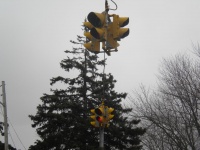
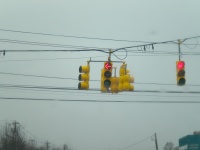
More often than not, signals will be found in clusters, or groups of 2 or more seperate signals held together by conduit-style piping and junctions. Wire is run from the cabinet, through these pipes and junctions, into the signals directly. These hardware examples are more commonly found with spanwire setups, and uncommonly seen with pole-mounted signals. The general pipe size today is 1½" diameter, but in the past sizes varied from 1¼" to 2" diameters. Many signal companies have also produced cluster hardware, such as Crouse-Hinds, Eagle, and Marbelite.
End Caps
6-sided
8-sided
Circus Tent
Stubby Finials
Long Finials
Junctions
T-junctions
2-sided Junctions
3-sided Junctions
4-sided Junctions
6-sided Junctions
Gooseneck Hangers
Usually seen with cluster hardware, gooseneck hangers are hollow aluminum(usually?) hangers with multiple holes along the top. The general idea of them is to allow a mounting point for signals and clusters that can sway slightly, hold a lot of weight, and provide a water-resistant entry point for wires to reach the signals. The multiple holes along the tops allow for pivotal adjustments to help counter-balance any weight offsets from clusters.
Spanwire Sign Brackets
These simple brackets firmly secure signs or sign clusters to span wires with minimal swaying and rocking. Backlit signs use gooseneck hangers.
Mounting Arms
Utilizing the same pipes and junctions as above, this mounting style also features special junction pieces that generally fit smoothly against poles, and are then held on to the pole itself with metal bands. Wiring can then be run through the pole or along the outside, into the arms and then into the signal.
Astro-Brackets
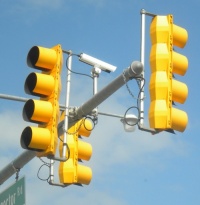
These sleek, modern brackets are usually found with mast arm setups. They generally hold one signal each, but can be found holding 2 signals, or a single doghouse configuration. Wiring is ran through the mast arm, out near the bracket's attachment point, through the bracket, and into the signal. These brackets come in varying heights, and can be adjusted on the job for different signal heights.
Slipfitters
Slipfitters are heavy aluminum pole caps with at least one 1½" hole to allow signals to attach to it, either directly or via cluster hardware. Some slipfitters have offset connection points so signals with backplates don't need extra hardware to fit on properly.
Flag-Mounts
Mainly made by Eagle and Crouse-Hinds, these now-defunct signal attachments allowed signals to horizontally mount to poles, with a small compartment between the two that usually held a terminal strip. These were usually seen with Crouse-Hind's Art Deco signals, and Eagle's Flatback signals. Flag-mounts are very hard to come by these days.
Compact Ped Housing Mounts
Called Clamshell Mounting Hardware by McCain, these compact attachment points allow pedestrian signals to mount almost directly to poles with no extra hardware required, creating a sleek, clean installation. The terminal strip housing is first clamped to the pole separately, the wiring connections are made, the pedestrian signal housing mounts onto the terminal strip housing, and then it is secured on with a bolt using a hex key or bit.
Direct Mounting
Seen in places such as Huntsville, Al., this mounting style utilizes mounting hardware to directly attach signal heads to mast arms, offering a utilitarian, water-proof mount. In these cases, the gooseneck hangers aren't used for mounting purposes.
Plumbizers
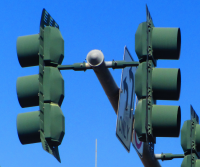
Almost like a horizontal slipfitter, plumbizers create attachment points on the tops and bottoms of one end, and slip onto mounted mast arm openings at the other end. The result is a water-tight secure fit, although the signal's top section is raised above the bottom sections to allow room for the plumbizer to mount properly. Wiring runs though the plumbizer itself and into the signal sections attached.
Structural Mounting
Seeing as signals are technically overglorified electrical housings with lights, it isn't entirely uncommon to see some signals mounted directly to structures with conduit or pvc fittings. These housings are usually secured to the wire piping or with bolts through the signal itself to the structure behind it. Common places to find signals like these are under elevated train track supports and under bridges.
